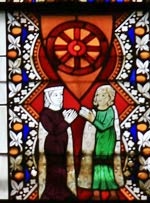Bolanden (noble family)
The Lords of Bolanden were Reichsministeriale, who were mainly wealthy in today's Donnersbergkreis .
history
Already before 1129 Werner I. von Bolanden founded the monastery of Hane near their ancestral castle Altbolanden . The Bolander initially worked as servants (church ministers) for the archbishops of Mainz . As such, Bolander were involved in the uprising of Mainz ministers, clerics and citizens against Archbishop Arnold von Selenhofen in 1160. The focus of her field of activity in the 12th century was in the Nahe and Wormsgau . In the area of the Donnersberg in particular , they seem to have pushed ahead with land development in the form of clearing on behalf of the Reich .
In the second half of the 12th century, Werner II von Bolanden appears in documents as the retinue of the Emperor and King of the German Empire Friedrich I (Barbarossa), obviously in the role of Reich Ministerial . In the service of the empire, he and his family achieved rapid ascent within a short time. Werner II von Bolanden appears as bailiff of the Ingelheim Empire and thus as administrator of the imperial estate on the Middle Rhine . Around 1190 he was enfeoffed by the Lorsch monastery with the former royal court Chamba (“curia in Chamben”) and with Sterrenberg Castle .
In the following years, the Bolander used their fiefdom to develop their own territory. Around 1220 the family divided into the lines Bolanden, Falkenstein and Hohenfels .
The main line of Bolanden received the hereditary court office of the Imperial for their services Stewards . She died out in 1386 with the cleric, Konrad von Bolanden, in the male line. As early as 1277, when Kunigunde von Bolanden married Count Heinrich I von Sponheim-Kreuznach , a son of Count Simon I von Sponheim-Kreuznach , the Sponheim-Bolanden sidelines had already formed. Their last representative was Heinrich II von Sponheim-Bolanden († 1393); his property came to the Nassau house through his granddaughter .
In 1246, Philip IV of the Falkenstein line was administrator of the Trifels Imperial Castle and guardian of the imperial regalia . Philip's wife was Isengard von Munzenberg, heir to part of the Munzenberg estate . Due to financial problems in the 14th century, a lot of property was lost, in 1418 the Falkenstein line died out (the main heirs were the lords of Eppstein and the counts of Solms ).
In 1602 the Hohenfels line finally went out, its inheritance fell a. a. to the Counts of Sponheim and the House of Nassau-Saarbrücken . Large parts of the property were sold to the Electoral Palatinate .
possession
In a loan book from the 13th century, all possessions and fiefs of Werner II von Bolanden (from the end of the 12th century) are recorded. The main focus of the property is in Wormsgau, especially around the Donnersberg. In addition to castles, rights in around 150 places have been handed down as fiefs from 44 lords.
Castles

coat of arms

The symbolism of the coat of arms of the Lords of Bolanden, like that of the Archbishops of Mainz, consisted of a wheel. It is very likely that these coats of arms have some kind of mutual relationship. Both wheels later differed both in color and in terms of the number of spokes: Mainz had a silver six-spoke wheel in the red field , while the Bolanden dynasties had a red wheel with eight spokes in the gold field. These designs from the mid-19th century lasted for a long time. The thesis was established that the Bolander wheel is derived from the Mainz wheel. In the meantime it has been proven that the Bolander wheel is older than that of Mainz, because the eight-spoke Bolander wheel was first documented in 1214, while the Mainz wheel was first documented in 1238.
Personalities
- Christian II von Bolanden , Archbishop of Mainz (1249–1251)
- Friedrich von Bolanden , Bishop of Speyer (1272–1302)
- Anna von Bolanden († 1320); Cistercian woman in the Kirschgarten monastery (Worms) , from whose possession a valuable codex has been preserved.
- Werner von Bolanden († 1324); Provost, Canon in Mainz and Speyer
literature
- Kurt Andermann : The Bolanden - Ministerials of the Staufer . In: Before times. History in Rhineland-Palatinate by Dieter Lau and Franz-Josef Heyen (eds.), Volume IV, Mainz 1988, pp. 69–86
- Christine Kleinjung: The Lords of Bolanden as the founder of the monastery , Alzeyer history sheets, issue 33, 2001, antiquity association for Alzey and the surrounding area; Article as a PDF document
- Wilhelm Fabricius : Explanations of the Historical Atlas of the Rhine Province , Volume 6, "The dominions of the lower Nahe region: the Nahegau and its surroundings", Bonn: Behrendt, 1914, p. 402 ff ( dilibri.de )
Web links
- Website of the Ingelheim Historical Society on the Lords of Bolanden
- Werner I. von Bolanden at genealogie-medieval
- Werner II von Bolanden at genealogie-medieval
- Werner III. von Bolanden at genealogie-medieval
Individual evidence
- ↑ Hans Döhn: Kirchheimbolanden: Die Geschichte der Stadt , Stadtverwaltung Kirchheimbolanden, 1968 and 1993, p. 84
- ^ Hans Döhn: Kirchheimbolanden: Die Geschichte der Stadt , Stadtverwaltung Kirchheimbolanden, 1968 and 1993, pp. 81–93.
- ↑ Overview with Heinrich Leo: Lectures on the history of the German people and empire , Bd. IV. Eduard Anton, Halle / S. 1865, pp. 599–607 ( Google Books ), in detail W. Fabricius: Explanations of the Historical Atlas of the Rhine Province , Volume 6, “The Lords of the Lower Nahe Area: the Nahegau and its Surroundings”, Bonn: Behrendt, 1914.
- ^ Adolph Köllner: History of the rule Kirchheim-Boland and Stauf , Wiesbaden, 1854, p. 14 ( Google Books )
- ↑ History Reipoltskirchen - Home. In: www.historie-reipoltskirchen.de. Retrieved January 19, 2017 .
